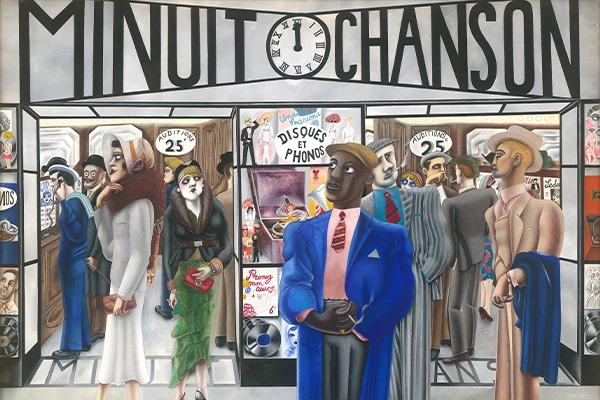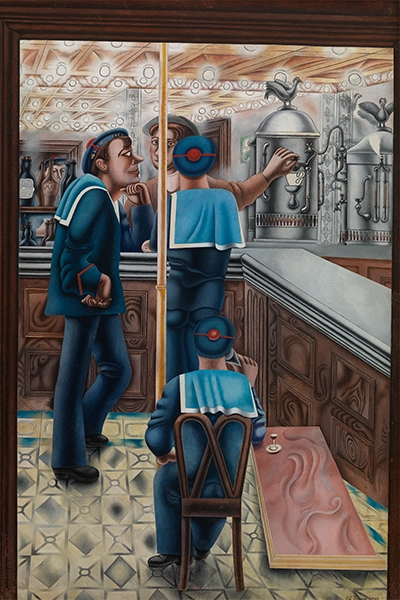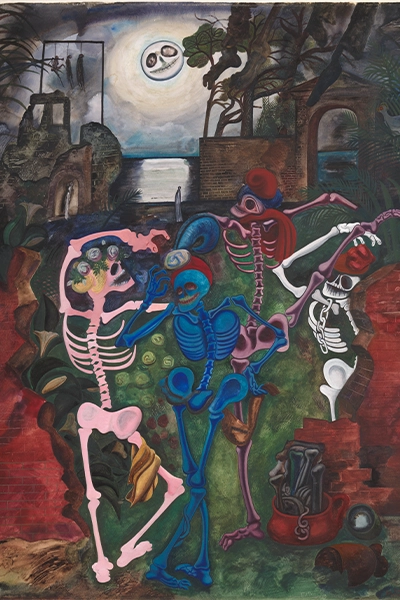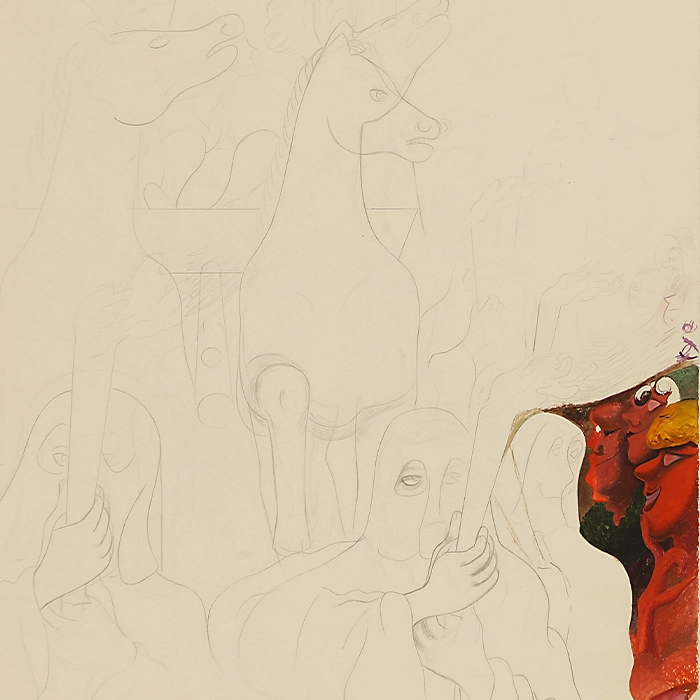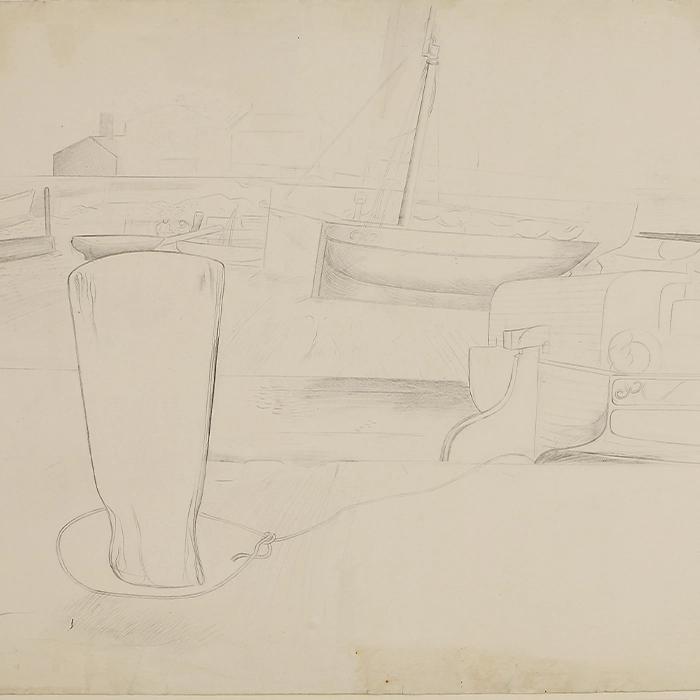14 April 2025
Edward Burra: ‘Painting of course is a sort of drug’
6 minutes
Private Clients Director Julie Webb talks to Sworders’ Head of Picture Department ahead of Tate Britain’s Edward Burra exhibition.
Tate Britain’s exhibition ‘Edward Burra’ will be the artist’s first retrospective in more than a decade and the first in London in 40 years, to highlight his hugely individual work and explore how the artist combined first-hand experiences and memories with visual references from newspapers, literature, art history, music and cinema.
“The painter’s unusual compositions, crafted with a distinct visual language, set him apart from his contemporaries,” says Amy Scanlon, Sworders’ Head of Picture Department. “Burra rejected formal affiliations with artistic groups even though his work was sometimes displayed in major Surrealism exhibitions.”
|
(Image: Edward Burra Minuit Chanson 1931 Private Collection © The estate of Edward Burra, courtesy Lefevre Fine Art, London / Bridgeman Images) |
She said: “Nobody else’s work looked like Burra’s and his depictions of sex workers, gay culture and underworld figures reflected his travels to Paris and the South of France in the 1920s and the US in the early 1930s. The satirical works captured an era and a rapidly changing society – everyday life from the perspective of an observer.”
On his travels Burra (1905 – 1976) encountered both cosmopolitan culture and those who lived on the edge of society and he sympathetically included them in his compositions, including Three Sailors at the Bar 1930 which is featured in the exhibition.
|
(Image: Edward Burra, Three Sailors at a Bar 1930. Private collection, courtesy of Hazlitt Holland-Hibbert. © The estate of Edward Burra, courtesy Lefevre Fine Art, London) |
He was also a great music lover and while visiting Boston and Harlem, in New York, he experienced jazz clubs during the Harlem Renaissance. He translated the energy into works including the vivid Red Peppers 1934-35, which captured the multi-cultural metropolis, while paintings such as Dancing Skeletons 1934 explored the artist’s growing interest in Mexican culture and the macabre.
|
(Image: Edward Burra Dancing Skeletons 1934. Tate, Purchased 1939) |
(Image: Edward Burra Red Peppers 1934-1935. Dundee Art Galleries and Museums (The McManus). © The estate of Edward Burra, courtesy Lefevre Fine Art, London) |
Burra’s lifelong affinity with ballet, opera and theatre is also highlighted through designs he produced for choreographers Frederick Ashton and Ninette de Valois, as well as productions for the Royal Opera House and Sadler’s Wells. His stage and costume designs remained fun and sardonic throughout his career.
Social commentaries of war
Burra’s experience of conflicts in Europe changed his work. After leaving Spain at the outbreak of the Spanish Civil War in 1936 his paintings became social commentaries, showing devilish figures committing violent acts, such as in War in the Sun 1938.
He lived most of his life in East Sussex and at the outbreak of the Second World War the South Coast heavily bombed and Burra witnessed the presence of Allied troops, imagined as monstrous mask wearing figures in Soldiers at Rye 1941.
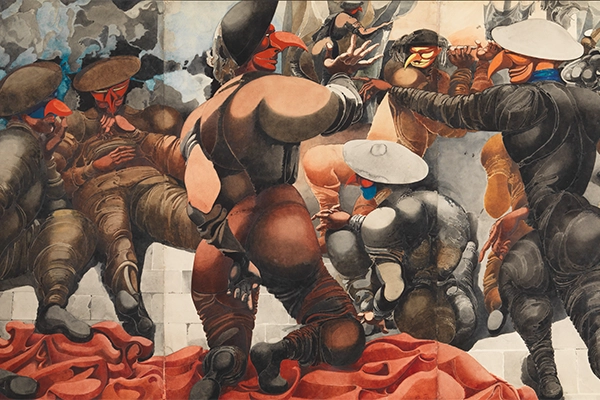
(Image: Edward Burra Soldiers at Rye 1941 Tate, Presented 1942)
His outlook was radically altered by war, but Burra found solace in his work, saying that ‘painting of course is a sort of drug’, and he composed works on a horizontal surface to help relieve his rheumatoid arthritis.
The final section of the exhibition will focus on Burra’s post-war life. Due to his declining health, his travel was limited to driving tours of Britain and Ireland, but he explored Cornwall and the Lake District in search of sublime natural beauty. He turned to otherworldly landscape paintings, suffused with environmental anxiety caused by the post-war industrial revolution. Mine shafts litter mountains and petrol stations occupy the countryside in Cornish Clay Mines 1970, in direct contrast to the carefree world Burra had once known and painted.
Three Burra works to go under hammer
While major 20th century art investors will always be on the look-out to build their collection, exhibitions such as Edward Burra at the Tate Britain ‘are always helpful to keep artists in people’s minds’ says Amy Scanlon.
She said: “Burra was not associated with any particular groups he has not been featured so often; the Tate Britain exhibition is the first London display of his work in four decades.
“Sworders’ Modern & Contemporary Art sale on April 15 features 440 lots including three Edward Burra works all with provenance, marked Sotheby's, London, 'Works from the Estate of Edward Burra, Lady Ritchie of Dundee and Associated Owners', July 3, 2002.
“This is a rare opportunity to consider three very different, very interesting pieces of work’.
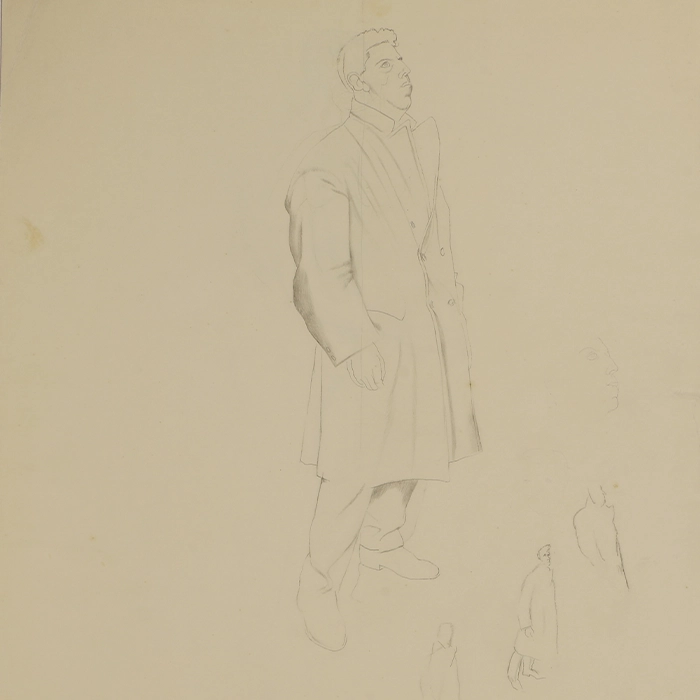 |
“Lot 289, Man standing in profile, 1923, verso: three figures, unframed pencil, 55.5 x 38cm, is estimated at £1,000-£1,500. The men featured in this two-sided drawing are typical of Burra, showing his unique ability to capture the human form in his distinctive style. His figures can be more caricatures rather than realistic representations. We do not know whether these were working drawings for a larger-scale painting but they may have been inspiration for his satirical scenes of urban life and queer culture. (Image: Burra Lot 289) |
|
|
“Lot 290, The Procession with 'E J Burra' estate stamp, is in pencil and watercolour, with a pencil drawing of dancers verso: three figures. It is 65 x 50cm, unframed and estimated at £2,000-£3,000. Here we have movements of the horses and ghoulish figures in this unfinished work. Burra has highlighted the scene with the vivid reds, yellow and green of the gouache which contrasts to the fine pencil drawings on the rest of the work. We see his ability as a draughtsman in the simple outlines to express the imagery and the movement of the material on the figures.” (Image: Burra Lot 290) |
|
|
“Lot 291, Harbour scene, c.1920-1930 is in pencil, with stamped signature. It is 57 x 78cm, unframed and estimated at £3,000-£5,000. This is my favourite work by Burra in the sale. The peaceful harbour is reminiscent of works I have seen by other artists working in the period such as Paul Nash and Eric Ravilious. There is a simplicity of line and the composition is not just straightforward by leaning towards a gentle abstraction. (Image: Burra Lot 291) |
Sworders’ Modern & Contemporary Art sale on April 15 features 440 lots including Ben Nicolson, Sir Terry Frost, Peter Lanyon, Roger Hilton, Trevor Bell and John Aldridge.
Visit sworder.co.uk
Edward Burra opens at the Tate Britain, London, from June 12 to October 19, 2025
Visit tate.org.uk
Insurance and valuations
If you have a fine art collection you should check it has the correct insurance cover. You don’t always need a stand-alone policy to insure artwork, but it shouldn’t be insured as “Contents”. Our recommendation is that any art in any form is insured under the “Art and Antiques” section of your policy. Ensure there is a good description of each item, with size and images.
Remember that repairing is different to replacing. A collection can be damaged by smoke, or a painting can fall off a wall. In these instances, you may not want to replace a piece, but having the right insurance policy in place will cover the costs of repair and restoration, or compensate you for a depreciation in value. For more information on how to insure your art please read our article: Insuring your artwork.
We also recommend that you get an up-to-date valuation. Make sure the valuation is for insurance purposes and that documentation is kept in a safe, secure, but memorable place in the event of a claim. We have a panel of recommended valuation companies that can assist by not only valuing your pieces now, but by also giving you up-to-date valuations going forward. Some of the insurers we work with will give a 25 per cent or even 50 per cent uplift for three years following a valuation to protect policyholders from rising prices.
To speak to Howden about your art insurance call 020 8256 4901 or email privateclients@howdeninsurance.co.uk

